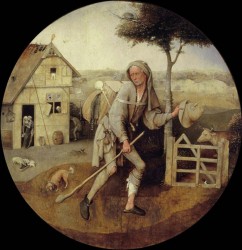
Zupnick 1968
“Bosch’s Representation of Acedia and the Pilgrimage of Everyman” (Irving L. Zupnick) 1968
[in: Nederlands Kunsthistorisch Jaarboek, 19 (1968), pp. 115-132]
[Also mentioned in Gibson 1983: 123 (E22)]
Zupnick approaches the Rotterdam Pedlar tondo from a historical perspective that takes into account other Bosch works and late-medieval moral philosophy as it was expressed in literature and folklore. This approach leads him to the conclusion that it was Bosch’s intention to depict the then popular theme of ‘the pilgrimage of Everyman’ and at the same time to demonstrate that Acedia (spiritual sloth, and more precisely weakness of faith) was the most important capital sin.
According to Zupnick the exterior of the Haywain triptych leads to a better understanding of the Rotterdam tondo because here the pedlar figure is part of a broader thematical programme. The central panel of the triptych depicts every capital sin, except Acedia. And yet Bosch considers Acedia the most important capital sin, since he depicts it in the closed wings. (Apparently Zupnick commits an interpretative error here: Bosch did depict Acedia in the central panel, see the lazy monk in the bottom-right corner.)
Zupnick notices a striking similarity between the pedlar in the closed wings of the Haywain and a figure in a painting by Giovanni Bellini (shortly after 1490) that is also said to depict Acedia. (A striking similarity is out of the question, though, so this argument can duly be discarded.) In the Haywain’s closed wings the capital sin Acedia is represented by the aggressively growling dog threatening the traveller. The latter tries to defend himself against the biting dog (so against Acedia) and to follow the path of salvation. The Rotterdam tondo has the same meaning: the protagonist is an Everyman figure hampered by his sins and vices, but nevertheless he tries to walk on the right path of salvation.
Zupnick concludes that Bosch was more a realist than a pessimist: he acknowledges man’s weaknesses, but spurs him on to overcome his sins by referring to the horrible punishments in hell. About this article, compare also De Bruyn 2001a: 182-183.
[explicit]